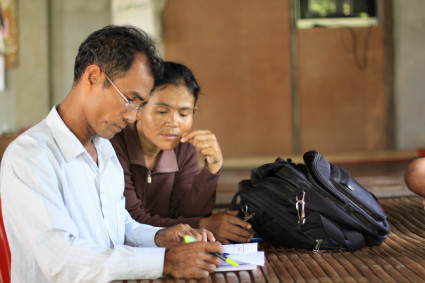In these conditions, how do you build a sense of community? How do you teach a community financial sustainability? Savings groups appear to be a key factor in resolving these challenging questions.
World Renew and our partners have found success in establishing savings groups in our target communities. The villagers learn to trust one another. They build a community network. They are empowered by owning the creation of their own financial security.
When a savings group is established in a community, a committee is set up to provide leadership to the group and manage the bookkeeping. The group members invest each month, anywhere from $1 to US$5.
Kim Sovann is the elected leader of the Takeo savings group. She only has a 4th grade education, but she is considered the most trustworthy person in her village. To help her in her elected role, she took classes in bookkeeping and leadership.
“It gives me a real sense of continuing my education and a new hope for the future,” Sovann says.
“It gives me a real sense of continuing my education and a new hope for the future,” Sovann says.
The village of Takeo is known for their frog legs, a well-seasoned meat that is grilled in markets throughout Cambodia. Through their savings group, members see their capital grow little by little. With more capital they have more money to loan out. By using these small loans, families can not only expand their businesses, they can also better manage their expenses—school fees, emergency healthcare, weddings, and small farming projects.
“We want to reduce the number of people who have to borrow money from micro-finance institutions or banks,” Sovann explains.
Formal institutions and banks charge high interest rates and are less flexible on their terms. They also charge late fees. For agriculture-reliant communities who are paid seasonally, it is difficult to function within the bank’s terms. Many families become bogged down in debt and eventually pull their children from school so that they can work to help support the family. Many families lost their land and homes when they were unable to repay these loans.
The uniqueness of the savings group in Takeo is that it is structured to be flexible. Group members there and in other locations must follow a few basic guidelines from World Renew, but each village can decide within these guidelines what their own rules are for the monthly payment schedule and interest. They can also decide as a group how to manage members who pay late—meaning there is generally more leniency.
Another advantage of this type of group over traditional lending institutions is that the money raised from the interest the group members agree to pay on their loans stays in the community. For example, 1% of the interest paid goes for administration fees, 1% goes back into the group’s capital, and 1% goes towards a larger community project such as road repair.
Transparency is the key to building trust within the group. Once a month, all of the group members meet to discuss what they are working on and share their failures and successes. They give each other support in developing their projects. Together, they collect money and then decide how to loan it out. Lao, the community organizer at Phal Dambong Church, explains how their savings group also plays a role in ministry to the community.
“Everyone in Takeo associates the savings group with the church. Most of the members of the savings group also attend the church and are involved in its activities. Not only are they an example of the good the church can do in the community, but the church can also see that groups can play an important role in the community’s development.”
Blessings,

